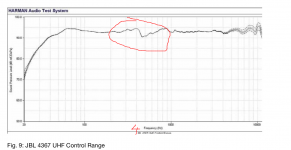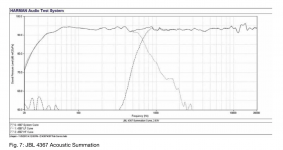The argument for a bigger transducer woofer will always remain. For Purifi, or any other manufacturer.
Hofmann's Iron Law doesn't go away, but the use of DSP and high power amplifiers allows you the bend the rules and push the driver to it's limits.
The goal of any speaker design is to provide amazing sound and unmatched clarity even at high SPLs, in the smallest enclosures possible.
How high in SPL depends on the audience and venue, how small depends on your venue and interior designer.
This has always been the goal, and will always be the case.
This is no different between any competitive market, whether it be a small portable bluetooth speaker of 1/4 L (250mL) cabinet volume (for personal/small group use), 1/2 cu ft cabinet for indoor living room use, or 250L for professional or outdoor use, supplanted by multiple 21” subwoofers.
But as a designer you make trade-offs of sensitivity/maximum SPL and low end response.
Clearly the Purifi 4-6.5" midwoofers offer something the other 4-6.5" manufacturers do not.
That doesn't take away the case for a 10-24" transducer that other manufacturers may make that plays louder and cleaner, that is lighter or less expensive than Purifi.
The question is, can Purifi make a better x” transducer than the competition. For a competitive price, without off-shoring it (and their IP) to the likes of Eminence or BMS etc with NSW6021-06, for instance.
If I could entertain a stadium of 30,000 people with a 100L speaker instead of a 200L speaker, I would.
If I could get something as high sensitivity as the JBL 15”, but with smooth and flat response as the Purifi 6.5” Alu, I would.
If I could entertain a whole outdoor theatre with something the size of a bedside table rather than something the size of the Altec A7, I would.
smaller lighter louder cheaper.
Hofmann's Iron Law doesn't go away, but the use of DSP and high power amplifiers allows you the bend the rules and push the driver to it's limits.
The goal of any speaker design is to provide amazing sound and unmatched clarity even at high SPLs, in the smallest enclosures possible.
How high in SPL depends on the audience and venue, how small depends on your venue and interior designer.
This has always been the goal, and will always be the case.
This is no different between any competitive market, whether it be a small portable bluetooth speaker of 1/4 L (250mL) cabinet volume (for personal/small group use), 1/2 cu ft cabinet for indoor living room use, or 250L for professional or outdoor use, supplanted by multiple 21” subwoofers.
But as a designer you make trade-offs of sensitivity/maximum SPL and low end response.
Clearly the Purifi 4-6.5" midwoofers offer something the other 4-6.5" manufacturers do not.
That doesn't take away the case for a 10-24" transducer that other manufacturers may make that plays louder and cleaner, that is lighter or less expensive than Purifi.
The question is, can Purifi make a better x” transducer than the competition. For a competitive price, without off-shoring it (and their IP) to the likes of Eminence or BMS etc with NSW6021-06, for instance.
If I could entertain a stadium of 30,000 people with a 100L speaker instead of a 200L speaker, I would.
If I could get something as high sensitivity as the JBL 15”, but with smooth and flat response as the Purifi 6.5” Alu, I would.
If I could entertain a whole outdoor theatre with something the size of a bedside table rather than something the size of the Altec A7, I would.
smaller lighter louder cheaper.
Last edited:
For anyone who hasn’t read it Mitch Barnett has a great review of the Purifi Demo speaker and amp, there are comparisons to his usual cinema style large driver system.
https://audiophilestyle.com/ca/revi...and-1et400a-amplifier-technology-review-r866/
I shudder to think how much a 15” Purifi driver would cost should they ever make one 😱
https://audiophilestyle.com/ca/revi...and-1et400a-amplifier-technology-review-r866/
I shudder to think how much a 15” Purifi driver would cost should they ever make one 😱
I repeat to you 15" cannot do midrange ! is quite simple just look at what do 😉 jbl in a 20k $$ semi active
The M2 is 12k.... and the FR of said speaker is not proof that a 15" can't do midrange.... the trend line is +\- 2.5db and that is fine. It is also the anechoic response. The higher the directivity of a loudspeaker the less room interaction, the sharper the IR. A smooth FR is desirable but how does one achieve this in a room. Directivity and room treatment is the common route....
Maybe you have a speaker to compare to the M2 that you deem superior so that we can continue to compare and contrast?
Below is the polar of the Gedlee Ns15 I believe. An example of the directivity achieved with large woofers and waveguides.
nice I feel the same with scanspeak revelator with Regular Pleasures ..with Purifi can only better
you must add the active sistem... 15" must cut under a 400-600 end of the story NO MIDThe M2 is 12k.... and the FR of said speaker is not proof that a 15" can't do midrange.... the trend line is +\- 2.5db and that is fine. It is also the anechoic response. The higher the directivity of a loudspeaker the less room interaction, the sharper the IR. A smooth FR is desirable but how does one achieve this in a room. Directivity and room treatment is the common route....
Maybe you have a speaker to compare to the M2 that you deem superior so that we can continue to compare and contrast?
Below is the polar of the Gedlee Ns15 I believe. An example of the directivity achieved with large woofers and waveguides.
View attachment 1102727
we can see the same XO point the is mid made by compressor driver !an 1,4 maybe ?Below is the polar of the Gedlee Ns15 I believe. An example of the directivity achieved with large woofers and waveguides.
Btw, Erin rates the JBL 4367 higher than the M2.
Many people rate the Salon 2 higher than the M2.
Many people rate the Salon 2 higher than the M2.
same big problem to me...Btw, Erin rates the JBL 4367 higher than the M2.
Many people rate the Salon 2 higher than the M2.
I’d put my speakers up against the M2 any day of the week, ending with a Y.

And they don’t (yet) use Purifi drivers, advanced waveguides, over-engineered low diffraction cabinets or bass boost EQ.

Give a blank cheque to Greg Timbers and he could do better speaker than the M2 in 2022.
In fact, he probably already has a whole bunch of Purifi drivers. Him and Joachim Gerhard and Nelson Pass and Dennis Murphy and the guys in R&D at Quested or Genelec or Neumann, or the ex-KEF or B&W guys...
And they don’t (yet) use Purifi drivers, advanced waveguides, over-engineered low diffraction cabinets or bass boost EQ.
Give a blank cheque to Greg Timbers and he could do better speaker than the M2 in 2022.
In fact, he probably already has a whole bunch of Purifi drivers. Him and Joachim Gerhard and Nelson Pass and Dennis Murphy and the guys in R&D at Quested or Genelec or Neumann, or the ex-KEF or B&W guys...
Last edited:
With that speaker the problem exists entirely in the vertical response mainly due to the asymmetrical horn. If you look at the Horizontal only in Erin's measurements, the response and directivity is really good.same big problem to me...
It's not clear quite what happened to the M2 because Harman's own measurements of it at some point had it ruler flat.
With that speaker the problem exists entirely in the vertical response mainly due to the asymmetrical horn. If you look at the Horizontal only in Erin's measurements, the response and directivity is really good.
It's not clear quite what happened to the M2 because Harman's own measurements of it at some point had it ruler flat.
View attachment 1102745
I think I understand what your intent is, with this measurement, Fluid.
If you look at Pierre’s measurement- he too shows JBL’s own measurement, and it shows something IS going on, between 400Hz and 600Hz too, it’s just smoothed, a bit like the one you posted.
Reference:
https://pierreaubert.github.io/spinorama/speakers/JBL M2/JBL/index_vendor.html
On the other hand- the Klippel Near Field Scanner is a real “heart breaker” @augerpro
It shows everything without make up, in clear daylight, the day after. The horizontal resolution is less than 2Hz!
Reference: www.erinsaudiocorner.com
Last edited:
the 4367 have the same woofer of M2 this is from Harman JBL......
the M2 have dsp too
Slightly different/revised woofer, the 2216Nd-1.
Here’s the spin:
smoother than M2. Sure it doesn’t go as low as the M2; but this isn’t using DSP to do active equalisation for the bass.
Reference:
https://www.erinsaudiocorner.com/loudspeakers/jbl_4367/
Meanwhile the March Audio Sointuva: a passive speaker with the paper cone PTT 6.5- smooth as a baby’s bum!
Look I’m not saying the spinorama is the be-all and end-all.
But if you only had 1 graph, this is what I’d take. I’d also take account of the sensitivity because that determines the dynamic range.
In fact, with Erin’s published over 100 speakers, and if you’ve stared at enough pixels as me, you probably come to a conclusion that CTA 2034 is not enough. It was published in 2015 based on a decades of research.
Version or Rev 2 should incorporate some kind of maximum SPL rating, consistent with CEA2010 definition for bass, and then some other rating above 120Hz, related to distortion (but perhaps not a blunt tool like THD).
Oh, and Erin’s globe charts.
One really needs to know if you’re getting a super wide dispersion speaker like Philharmonic Audio’s BMR Tower or Monitor or a narrower dispersion speaker like one with a waveguide.
Donate @bikinpunk
Last edited:
The reason some of the M2 plots are very smooth on-axis, is the reviewer is using the amps (Crown I think) that Harman modifies for use with high end installs. The amps have DSP with multiple filters in them. M2 can be used alone, but they were engineered as a package with those amps for best results.
"How high" also depends on sound quality desired. Clipped peaks are not desirable...many small speaker users like to pretend like they are actually faithfully recreating the signal when in fact, amplitude is distorted when factoring in distance and significant volume, as well as bass performance. Midbass is usually the area of interest for this topic. Also, placing system cutoff above content cutoff is a corner cutHow high in SPL depends on the audience and venue, how small depends on your venue and interior designer.
This has always been the goal, and will always be the case.
Directivity, as youve pointed out, is of high importance, vs a 2.5db margin of error in an anechoic response.
So looking at your set of speakers, your anechoic looks great... but the real show starts in the room.... and the higher directivity speaker will look closer to its anechoic response.... the speaker with a wider polar will be farthest removed from its anechoic response... where your speaker will land vs the M2, in the room. Has yet to be sorted.
But youve already increased sources and xover filters, not off to a good start.
That could be so misconstrued 🙂A lot of factors go into making a wiggle.
- Home
- Loudspeakers
- Multi-Way
- Exploring Purifi Woofer Speaker Builds

